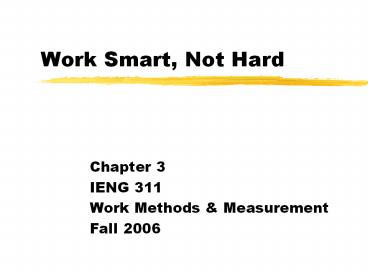Work Smart, Not Hard - PowerPoint PPT Presentation
Title:
Work Smart, Not Hard
Description:
Better seeds or better fertilizer or herbicides for better yields. bushels per acre ... would travel at the speed of sound, and go about 600 miles on a thimble of gas. ... – PowerPoint PPT presentation
Number of Views:4254
Avg rating:3.0/5.0
Title: Work Smart, Not Hard
1
Work Smart, Not Hard
- Chapter 3
- IENG 311
- Work Methods Measurement
- Fall 2006
2
Changes in the Standard of Living
- See next two slides
- Make predictions about 2030
3
(No Transcript)
4
(No Transcript)
5
Productivity
- The ratio between input and output
- 4 classic factors
- land
- materials
- machines
- labor
6
Land Productivity
- Better seeds or better fertilizer or herbicides
for better yields - bushels per acre
- faster maturing trees
- output per unit of land increases
7
Materials Productivity
- Reduce scrap or waste so that a higher percentage
of the raw material is utilized - use of non-corrosive materials or coatings to
increase the life of products (e.g. bridges,
highways, tools)
8
Machine Productivity
- Schedule truck loads in both directions
- using ceramic coated or carbide coated cutting
tools to increase cutting speeds and prolong
cutter life - using a word processor to produce a letter
- using email rather than US mail
- using machines over 2 or 3 shifts rather than one
9
Labor Productivity
- Improve the work methods
- use a fixture to hold parts for assembly with two
hands rather than one
10
Productivity Perspectives
- Developed countries have used materials, energy,
and information to replace labor - Cheap energy and materials keep productivity high
(energy crises effects) - In the US, we have matured such that labor prices
dominate productivity - In developing countries, they usually have cheap
labor to offset transportation costs to big
markets.
11
Productivity Perspectives
- In the early 1900s, 85 of US workers were in
ag, now its less than 3 - In 1950, 73 of US employees were in production
or mfg, now its less than 15 - In 2000, at least 44 of all workers were in data
services - In 2030, ??
12
Productivity Perspectives
- In 1990, for the first time ever, companies spent
more money on computing and communications gear
than the combined money spent on industrial,
mining, farm, and construction equipment - In 2000, no developed country had more than 1/6
of its workforce in the traditional roles of
making and moving goods - In 2030, ??
13
Productivity Perspectives
- In 1993, 19,000,000 people carried pagers and
12,000,000,000 messages were left in voice
mailboxes - There has been more information produced in the
last 30 years than during the previous 5000
14
Productivity Perspectives
- The first practical industrial robot was
introduced in the 1960s - In 1982 there were approximately 32,000 robots
used in the US - Today there are over 20,000,000
15
Productivity Perspectives
- Computer power is 8000 times less expensive than
it was 30 years ago - With similar progress in automotive technology,
today we could buy a Lexus for 2. It would
travel at the speed of sound, and go about 600
miles on a thimble of gas.
16
Define Productivity
- The measure of the amount of OUTPUT per unit of
INPUT
17
Cost of Living Changes
18
Conclusion
- The Industrial Age has given way to the
Information Age - What Age will your grandchildren be living in??
19
Who should benefit?
- Obviously consumers
- Employers vs employees??
- Will workers lose their jobs or have them
replaced by technology?
20
Productivity Waste Sources
- Improper product design
- Nonstandardization
- Incorrect quality standards
- Material waste
- Energy waste
21
Productivity Waste Sources
- Poor methods
- poor macro method
- telephone tag vs email, fax, answering machine
- hand entry vs bar codes
- poor micro method
- waitress enters orders in handwriting vs circling
pre-printed items - poor arrangement
- poor equipment usage
22
Productivity Waste Sources
- Poor Management
- too many product models
- poorly design product
- poor production scheduling
- poor maintenance
- poor safety and health
- Poor Workers
- soldiering, absenteeism, etc.

















![[PDF READ ONLINE] Tanzania - Culture Smart!: The Essential Guide to Customs & Culture PowerPoint PPT Presentation](https://s3.amazonaws.com/images.powershow.com/10120512.th0.jpg?_=202409051210)



![[PDF READ ONLINE] Tanzania - Culture Smart!: The Essential Guide to Customs & Culture PowerPoint PPT Presentation](https://s3.amazonaws.com/images.powershow.com/10102703.th0.jpg?_=20240820033)
![[PDF READ ONLINE] Tanzania - Culture Smart!: The Essential Guide to Customs & Culture PowerPoint PPT Presentation](https://s3.amazonaws.com/images.powershow.com/10100554.th0.jpg?_=20240816115)








